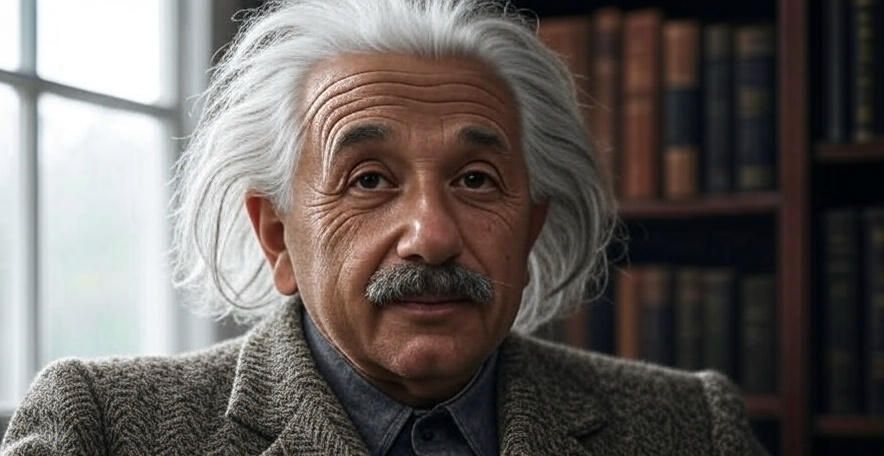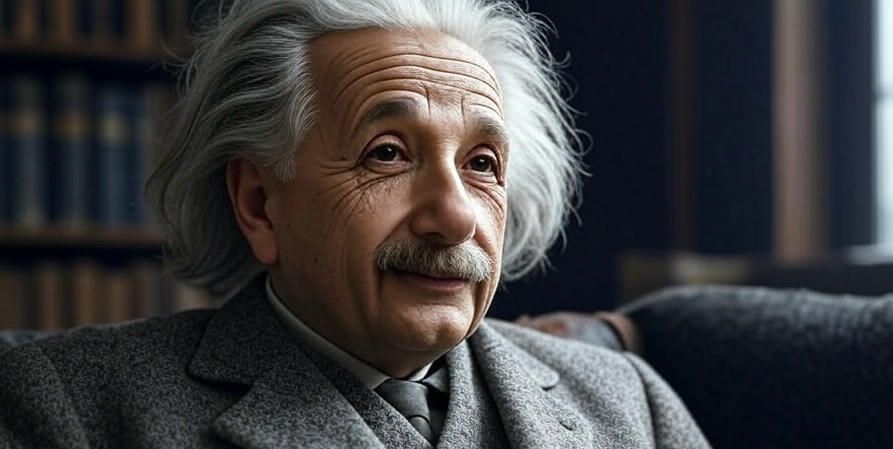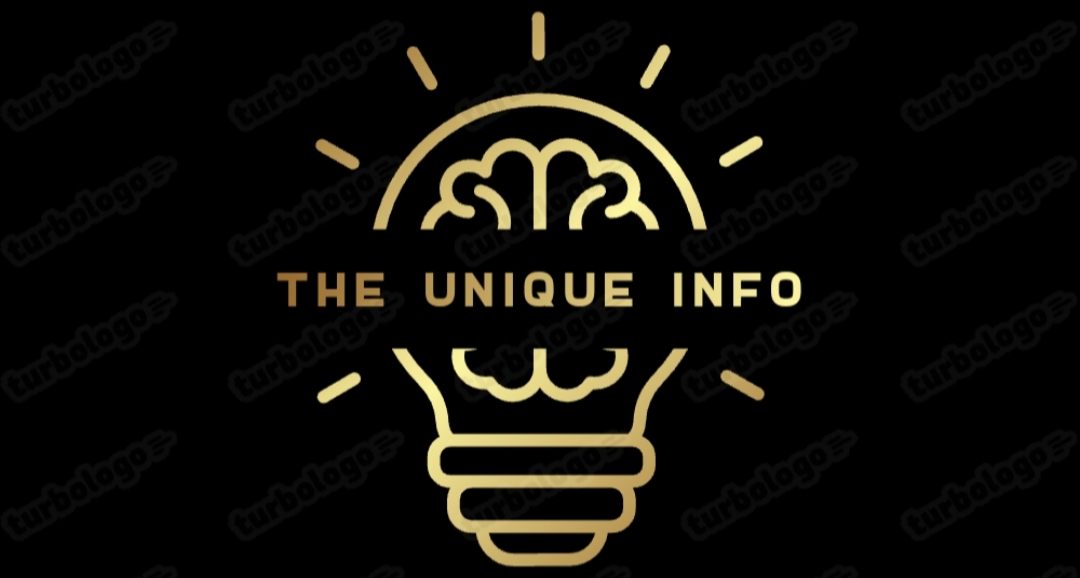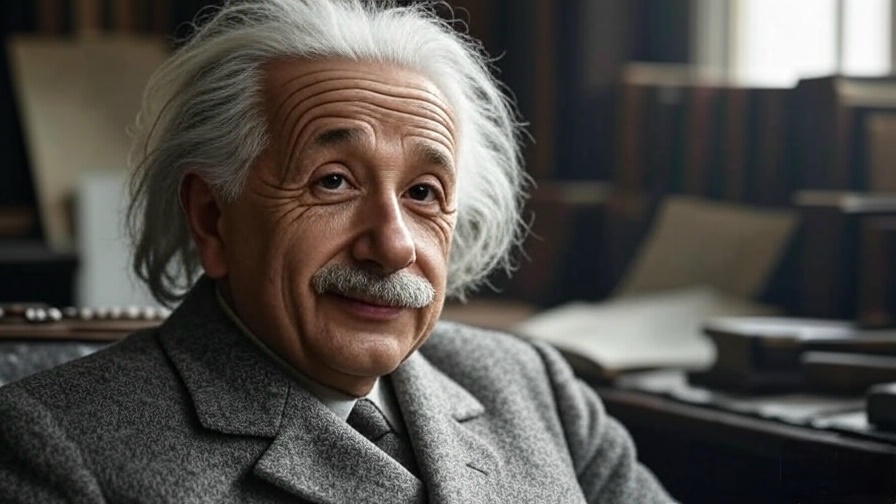Albert Einstein is a name synonymous with brilliance, curiosity, and revolutionary ideas. His contributions to science, particularly in the field of physics, have shaped our understanding of the universe in ways that continue to influence modern technology and thought. From his theory of relativity to his work on the photoelectric effect, Einstein’s legacy is vast and enduring. This article explores his life, achievements, and impact in a simple and detailed way, making it accessible to all audiences—whether you’re a student, a curious reader, or someone interested in the wonders of science.

𝗘𝗮𝗿𝗹𝘆 𝗟𝗶𝗳𝗲: 𝗔 𝗖𝘂𝗿𝗶𝗼𝘂𝘀 𝗠𝗶𝗻𝗱
Albert Einstein was born on March 14, 1879, in Ulm, a small town in the Kingdom of Württemberg, Germany. His parents, Hermann and Pauline Einstein, were a middle-class Jewish couple. Hermann ran an electrical engineering business, while Pauline was a homemaker with a love for music. From a young age, Albert showed a deep curiosity about the world. At age five, he was fascinated by a compass his father gave him, wondering what invisible force made the needle point north. This early spark of curiosity would define his life.
As a child, Einstein was quiet and introspective. He didn’t speak fluently until he was about seven, leading some to mistakenly think he was slow. However, his mind was always active, pondering questions others overlooked. He loved mathematics and taught himself advanced concepts, often outpacing his school curriculum. Despite his intellectual gifts, Einstein struggled with the rigid structure of German schools, which emphasized memorization over creativity. He clashed with teachers and felt stifled, a frustration that would later shape his unconventional approach to science.
In 1894, when Einstein was 15, his family moved to Italy due to financial difficulties with their business. Albert stayed behind briefly to finish school but soon joined his family, dropping out of high school. He later enrolled in a Swiss school in Aarau, where the teaching style encouraged independent thinking. This environment suited him, and in 1896, he entered the Swiss Federal Polytechnic in Zurich to study physics and mathematics. It was here that he began to develop the ideas that would change the world.
𝗧𝗵𝗲 𝗠𝗶𝗿𝗮𝗰𝗹𝗲 𝗬𝗲𝗮𝗿: 𝟭𝟵𝟬𝟱
After graduating in 1900, Einstein struggled to find a teaching job. He took odd jobs, including tutoring, before landing a position as a patent clerk in Bern, Switzerland, in 1902. The job was modest, but it gave him time to think and work on his scientific ideas. In 1905, at the age of 26, Einstein published four groundbreaking papers in the journal Annalen der Physik. This period, known as his “miracle year,” established him as one of the greatest scientists of all time. Let’s explore these papers in simple terms:
✓ The Photoelectric Effect: Einstein proposed that light is made up of tiny packets of energy called “quanta” (later called photons). He suggested that when light hits a material, these photons can knock out electrons, creating an electric current. This idea explained a phenomenon that puzzled scientists and laid the foundation for quantum mechanics. In 1921, Einstein won the Nobel Prize in Physics for this work, not for relativity, as many assume.
✓ Brownian Motion: Einstein provided evidence for the existence of atoms by studying the random movement of particles in a liquid. He showed that the zigzagging motion of tiny particles (like pollen grains in water) was caused by collisions with invisible atoms. This confirmed the atomic theory, which was still debated at the time.
✓ Special Theory of Relativity: This paper introduced the idea that the laws of physics are the same for all observers, regardless of their speed, as long as they’re moving at a constant velocity. A key concept was that the speed of light (about 300,000 kilometers per second) is constant, no matter how fast you’re moving. This led to strange but true conclusions, like time slowing down for objects moving very fast (a phenomenon called time dilation).
✓ Mass-Energy Equivalence: Perhaps the most famous equation in history, E = mc², came from this work. It shows that mass (m) and energy (E) are interchangeable, with c being the speed of light. In simple terms, a small amount of mass can be converted into a huge amount of energy.
This idea later became critical for understanding nuclear reactions.These papers revolutionized physics, but Einstein was still relatively unknown. He continued working at the patent office, unaware that his ideas would soon change the world.

𝗧𝗵𝗲 𝗚𝗲𝗻𝗲𝗿𝗮𝗹 𝗧𝗵𝗲𝗼𝗿𝘆 𝗼𝗳 𝗥𝗲𝗹𝗮𝘁𝗶𝘃𝗶𝘁𝘆
In 1915, Einstein published his general theory of relativity, a more comprehensive version of his earlier work. While special relativity dealt with objects moving at constant speeds, general relativity included acceleration and gravity. Einstein proposed that gravity is not a force, as Isaac Newton described, but a curvature of space and time caused by massive objects like planets and stars.
Imagine a trampoline: if you place a heavy ball in the center, it creates a dip. Smaller objects, like marbles, will roll toward the dip. Similarly, massive objects like the Sun curve spacetime, causing planets to orbit around it. This idea was radical, as it redefined gravity as a geometric property of the universe.
To test his theory, Einstein predicted that light from distant stars would bend as it passed near the Sun due to its gravitational field. In 1919, British astronomer Arthur Eddington led an expedition during a solar eclipse. to observe this effect. The results confirmed Einstein’s predictions, and he became an overnight global celebrity. Newspapers hailed him as the successor to Newton, and his name became synonymous with genius.
𝗘𝗶𝗻𝘀𝘁𝗲𝗶𝗻’𝘀 𝗟𝗮𝘁𝗲𝗿 𝗟𝗶𝗳𝗲
As Einstein’s fame grew, so did his influence. In 1930, he moved to the United States to escape the rise of Nazism in Germany. He accepted a position at the Institute for Advanced Study in Princeton, New Jersey, where he remained until his death. Einstein was deeply troubled by the political climate in Europe, particularly the persecution of Jews. As a Jew, he faced antisemitic attacks, and his global stature made him a target for Nazi propaganda.
In 1939, Einstein played a pivotal role in alerting the world to the dangers of nuclear weapons. He co-signed a letter to President Roosevelt, warning that Nazi Germany might be developing an atomic bomb based on nuclear fission. This led to the Manhattan Project, though Einstein himself was not directly involved due to security concerns. Later, he regretted his role, as the bombs dropped on Hiroshima and Nagasaki in 1945 caused immense destruction. He became a vocal advocate for peace and nuclear disarmament.
Einstein continued his scientific work, focusing on a unified field theory to combine gravity and electromagnetism. Despite years of effort, he didn’t succeed, as the mathematics and experimental evidence weren’t yet advanced enough. Still, his quest inspired later generations of physicists.
𝗣𝗲𝗿𝘀𝗼𝗻𝗮𝗹 𝗟𝗶𝗳𝗲 𝗮𝗻𝗱 𝗣𝗲𝗿𝘀𝗼𝗻𝗮𝗹𝗶𝘁𝘆
Einstein’s personal life was complex. He married Mileva Marić, a fellow physicist, in 1903, and they had two sons, Hans Albert and Eduard, as well as a daughter, whose fate remains unclear (she may have been given up for adoption). The marriage was strained by Einstein’s focus on work and ended in divorce in 1919. He later married his cousin Elsa Löwenthal, who cared for him until her death in 1936.
Einstein was known for his quirky personality. He had a playful sense of humor, loved sailing, and played the violin to relax. He often appeared disheveled, with wild hair and mismatched clothes, embracing his image as an eccentric genius. Despite his fame, he remained humble, valuing ideas over accolades. He was also a humanitarian, advocating for civil rights, Zionism, and global cooperation.
𝗘𝗶𝗻𝘀𝘁𝗲𝗶𝗻’𝘀 𝗟𝗲𝗴𝗮𝗰𝘆
Einstein died on April 18, 1955, at age 76, but his impact endures. His theories have been confirmed repeatedly through experiments and observations. For example:
✓ GPS Technology: The clocks in GPS satellites run slightly slower than those on Earth due to time dilation from both high speeds (special relativity) and weaker gravity (general relativity). Einstein’s equations are used to correct these differences, ensuring accurate navigation.
✓ Black Holes: General relativity predicted black holes, regions where gravity is so strong that not even light can escape. In 2019, the first image of a black hole’s shadow confirmed Einstein’s ideas.
✓ Nuclear Energy: The equation E = mc² underpins nuclear power and weapons, where tiny amounts of mass release enormous energy.
✓ Cosmology: Einstein’s work helped explain the expansion of the universe, leading to the Big Bang theory.
Beyond science, Einstein’s image as a symbol of genius has permeated popular culture. His face appears on T-shirts, mugs, and memes, often alongside his famous equation. His quotes, like “Imagination is more important than knowledge,” inspire creativity and curiosity.
𝗖𝗵𝗮𝗹𝗹𝗲𝗻𝗴𝗲𝘀 𝗮𝗻𝗱 𝗖𝗼𝗻𝘁𝗿𝗼𝘃𝗲𝗿𝘀𝗶𝗲𝘀
Einstein wasn’t infallible. He initially resisted quantum mechanics, famously saying, “God does not play dice,” to express his discomfort with the theory’s reliance on probability. Though he helped lay its foundations, he believed the universe should be deterministic, not random. Over time, quantum mechanics was validated, showing that even Einstein could be wrong.
His political activism also sparked controversy. His support for socialism and criticism of capitalism drew scrutiny during the Cold War, and the FBI kept a file on him. Some criticized his Zionism, though he envisioned a peaceful coexistence between Jews and Arabs in Palestine.
𝗪𝗵𝘆 𝗘𝗶𝗻𝘀𝘁𝗲𝗶𝗻 𝗠𝗮𝘁𝘁𝗲𝗿𝘀 𝗧𝗼𝗱𝗮𝘆
Einstein’s story is one of perseverance, imagination, and the power of questioning. He wasn’t a perfect student, yet he reshaped our understanding of reality. His ability to think differently reminds us that innovation often comes from challenging the status quo.
For students, Einstein’s life shows that curiosity and hard work can overcome obstacles. For scientists, his rigor and creativity set a high standard. For everyone, his advocacy for peace and equality highlights the responsibility to use knowledge for good.
In a world facing challenges like climate change, artificial intelligence, and global conflicts, Einstein’s legacy encourages us to think boldly and act wisely. His work reminds us that the universe is vast, mysterious, and full of possibilities waiting to be explored.
𝗖𝗼𝗻𝗰𝗹𝘂𝘀𝗶𝗼𝗻
Albert Einstein was more than a scientist; he was a visionary who dared to ask big questions. From his humble beginnings to his world-changing theories, he showed that a single mind can alter history. His theories of relativity, contributions to quantum mechanics, and advocacy for humanity continue to inspire and guide us.
Whether you’re marveling at the stars, using GPS to navigate, or simply pondering life’s mysteries, Einstein’s influence is all around you. His life teaches us to stay curious, embrace challenges, and never stop imagining. As he once said, “A person who never made a mistake never tried anything new.” Let’s honor his legacy by daring to explore the unknown.

